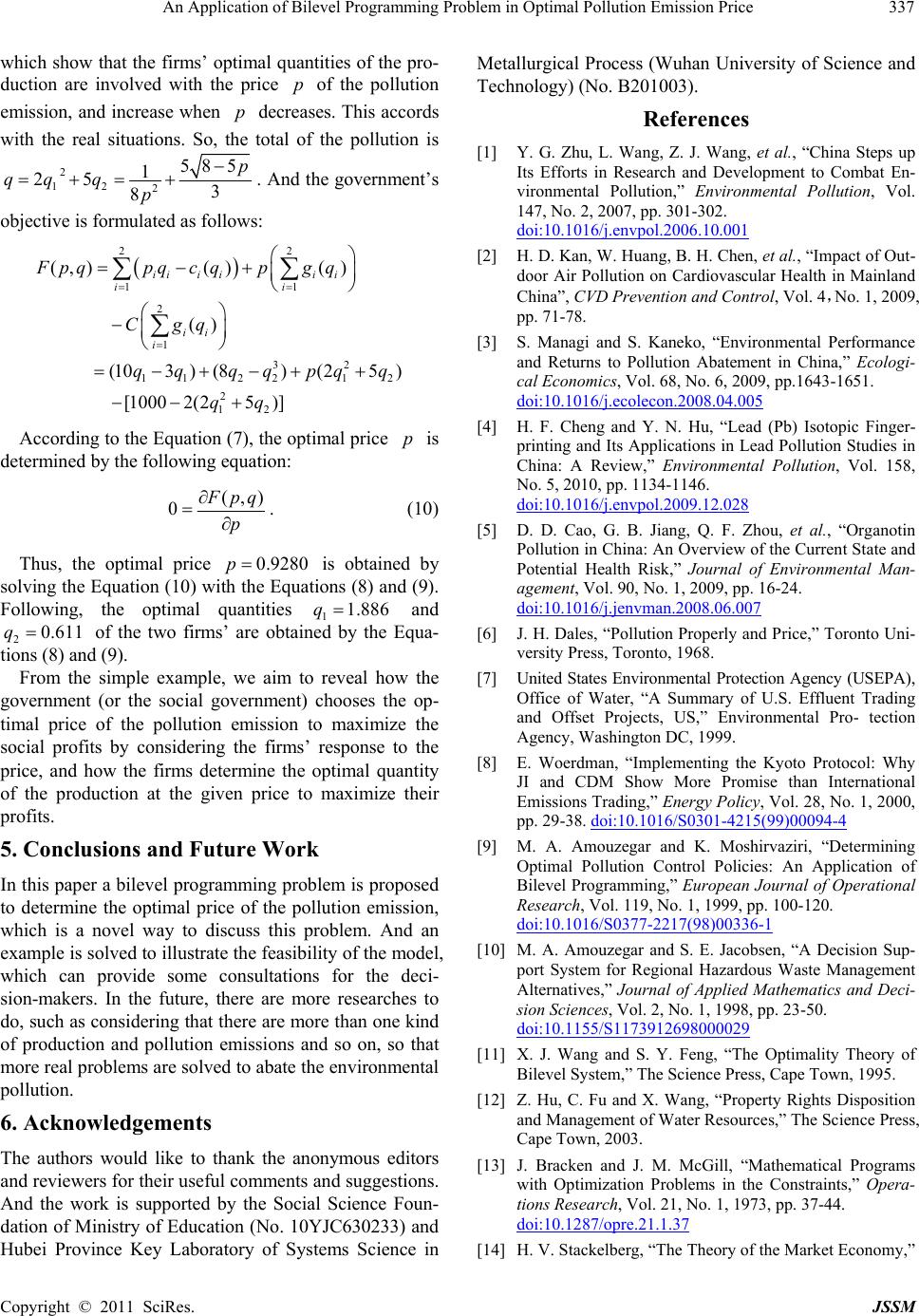
An Application of Bilevel Programming Problem in Optimal Pollution Emission Price337
which show that the firms’ optimal quantities of the pro-
duction are involved with the price of the pollution
emission , and increas e when decreases. This accords
with the real situations. So, the total of the pollution is
p
p
22
12
58 5p
1
25 3
8
qqqp
. And the government’s
objective is formulated as follows:
22
11
2
1
32
11221 2
2
12
()() ()
()
(103)(8)(25)
[10002(25)]
ii iiii
ii
ii
i
Fpqpq cqpgq
Cgq
qqqqpq q
qq
According to the Equation (7), the optimal price is
determined by the following equation: p
(
0)
pq
p
. (10)
Thus, the optimal price 0 9280p
is obtained by
solving the Equation (10) with the Equations (8) and (9).
Following, the optimal quantities 1 and
2 of the two firms’ are obtained by the Equa-
tions (8) and (9).
1886q
0 611q
From the simple example, we aim to reveal how the
government (or the social government) chooses the op-
timal price of the pollution emission to maximize the
social profits by considering the firms’ response to the
price, and how the firms determine the optimal quantity
of the production at the given price to maximize their
profits.
5. Conclusions and Future Work
In this paper a bilevel programming problem is proposed
to determine the optimal price of the pollution emission,
which is a novel way to discuss this problem. And an
example is solved to illustrate the feasibility of the model,
which can provide some consultations for the deci-
sion-makers. In the future, there are more researches to
do, such as considering that there are more than one kind
of production and pollution emissions and so on, so that
more real problems are solved to ab ate the env ironmental
pollution.
6. Acknowledgements
The authors would like to thank the anonymous editors
and reviewers for their useful comments and suggestions.
And the work is supported by the Social Science Foun-
dation of Ministry of Edu cation (No. 10YJC630233) and
Hubei Province Key Laboratory of Systems Science in
Metallurgical Process (Wuhan University of Science and
Technology) (No. B201003).
References
[1] Y. G. Zhu, L. Wang, Z. J. Wang, et al., “China Steps up
Its Efforts in Research and Development to Combat En-
vironmental Pollution,” Environmental Pollution, Vol.
147, No. 2, 2007, pp. 301-302.
doi:10.1016/j.envpol.2006.10.001
[2] H. D. Kan, W. Huang, B. H. Chen, et al., “Impact of Out-
door Air Pollution on Cardiovascular Health in Mainland
China”, CVD Prevention and Control, Vol. 4,No. 1, 2009,
pp. 71-78.
[3] S. Managi and S. Kaneko, “Environmental Performance
and Returns to Pollution Abatement in China,” Ecologi-
cal Economics, Vol. 68, No. 6, 2009, pp.1643-1651.
doi:10.1016/j.ecolecon.2008.04.005
[4] H. F. Cheng and Y. N. Hu, “Lead (Pb) Isotopic Finger-
printing and Its Applications in Lead Pollution Studies in
China: A Review,” Environmental Pollution, Vol. 158,
No. 5, 2010, pp. 1134-1146.
doi:10.1016/j.envpol.2009.12.028
[5] D. D. Cao, G. B. Jiang, Q. F. Zhou, et al., “Organotin
Pollution in China: An Overview of the Current State and
Potential Health Risk,” Journal of Environmental Man-
agement, Vol. 90, No. 1, 2009, pp. 16-24.
doi:10.1016/j.jenvman.2008.06.007
[6] J. H. Dales, “Pollution Properly and Price,” Toronto Uni-
versity Press, Toronto, 1968.
[7] United States Environmental Protection Agency (USEPA),
Office of Water, “A Summary of U.S. Effluent Trading
and Offset Projects, US,” Environmental Pro- tection
Agency, Washington DC, 1999.
[8] E. Woerdman, “Implementing the Kyoto Protocol: Why
JI and CDM Show More Promise than International
Emissions Trading,” Energy Policy, Vol. 28, No. 1, 2000,
pp. 29-38. doi:10.1016/S0301-4215(99)00094-4
[9] M. A. Amouzegar and K. Moshirvaziri, “Determining
Optimal Pollution Control Policies: An Application of
Bilevel Programming,” European Journal of Operational
Research, Vol. 119, No. 1, 1999, pp. 100-120.
doi:10.1016/S0377-2217(98)00336-1
[10] M. A. Amouzegar and S. E. Jacobsen, “A Decision Sup-
port System for Regional Hazardous Waste Management
Alternatives,” Journal of Applied Mathematics and Deci-
sion Sciences, Vol. 2, No. 1, 1998, pp. 23-50.
doi:10.1155/S1173912698000029
[11] X. J. Wang and S. Y. Feng, “The Optimality Theory of
Bilevel System,” The Science Press, Cape Town, 1995.
[12] Z. Hu, C. Fu and X. Wang, “Property Rights Disposition
and Management of Water Resources,” The Science Press,
Cape Town, 2003.
[13] J. Bracken and J. M. McGill, “Mathematical Programs
with Optimization Problems in the Constraints,” Opera-
tions Research, Vol. 21, No. 1, 1973, pp. 37-44.
doi:10.1287/opre.21.1.37
[14] H. V. Stackelberg, “The Theory of the Market Economy,”
Copyright © 2011 SciRes. JSSM